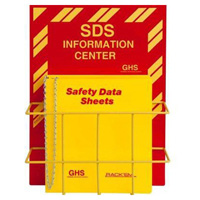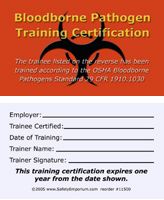



Find all of your laboratory and workplace safety supplies at Safety Emporium!
 Mole |
 Glossary Index |
 MSHA |
| MSDS Topics |
Free Sites | FAQ's | Regulations | Glossary | Software | Suppliers |
| Books | Forum | Poll | Fun stuff | Quiz | Store | |
| Understand your MSDS with the MS-Demystifier | Search ALL our MSDS info | |||||
mus is the RTECS abbreviation for mouse. On some Safety Data Sheets , the abbreviation m may also be used.
mus is not a standard abbreviation for "muscle" or "muscular". For example. RTECS uses ims for "intramuscular".
mus appears on SDS's in the context of a lethal or toxic dose concentration. Examples of such concentrations include LD50 and LC50 values as well as related terms such as TDLo (toxic dose, low), LDLo (lethal dose, low), and LCLo (lethal concentration, low).

Your employees can stay informed and comply with OSHA regulations with SDS information stations and compliance products from Safety Emporium.
In the following examples from actual SDS's, "mg/kg" refers to the specified quantity (in g or mg) of the test chemical per kilogram (kg) of animal body weight:
7,548 mg/kg (inhalation, mus)
ORL-MUS 4 mg kg-1
LD50:(IMS,MUS) 1190 MG
In the examples above, ORL-MUS above refers to an oral exposure route in mice and (IMS,MUS) refers to intramuscular injection in mice.
It is sometimes difficult to assess the relative risks of chemicals when one LD50 is given for inhalation and another is given for injection. One has to consider the plausible routes of entry. For example, exposure to a vapor is much more likely through inhalation than through ingestion or injection.
Animal test results do not always accurately assess the risks to humans, but even so, they have historically been quite valuable for assessing the relative risks of chemicals in the workplace. The lower the LD50 or related value, the more toxic the material. Animal testing raises ethical issues, particularly for non-essential applications like cosmetics. For perspectives on animal testing and biomedical research see Further Reading (below).
Always read your SDS to assess the hazards of a substance. Section 11 (toxicological information) will tell you what hazards you face and Section 8 (exposure controls/personal protection) will describe whatever engineering controls or personal protective equipment may be necessary to protect you from workplace exposure.

Get your bloodborne pathogen safety materials from Safety Emporium.
See also: intraperitoneal, intravenous, molality, subcutaneous.
Additional definitions from Google and OneLook.
Entry last updated: Tuesday, January 3, 2023. This page is copyright 2000-2025 by ILPI. Unauthorized duplication or posting on other web sites is expressly prohibited. Send suggestions, comments, and new entry desires (include the URL if applicable) to us by email.
Disclaimer: The information contained herein is believed to be true and accurate, however ILPI makes no guarantees concerning the veracity of any statement. Use of any information on this page is at the reader's own risk. ILPI strongly encourages the reader to consult the appropriate local, state and federal agencies concerning the matters discussed herein.